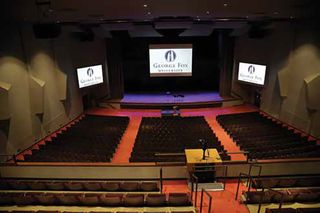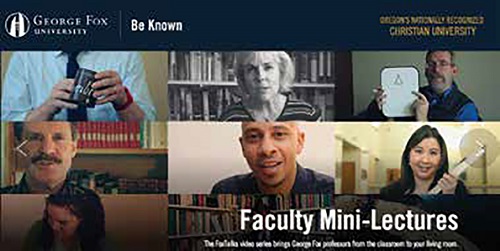Situated in the heart of the Willamette Valley just outside of Portland, Oregon, George Fox is a Christian university that prepares students spiritually, academically and professionally across all majors and degrees with programs that ready students for real world careers. One of the ways the school achieves this is through hands on learning with professional equipment, of which there is no shortage in the university’s Cinema and Media Communication Department.
George Fox University is emphasizing next-generation technology and hands-on training. Not only do the Event Video and Broadcast News classes learn on professional equipment, including Crestron control and Blackmagic Design’s ATEM 1 M/E Production Switchers, but students also benefit from the opportunity to work live productions in George Fox’s 1,119 seat Bauman Auditorium, used regularly for university chapel, special lectures and band, choir and orchestra concerts. The auditorium also hosts performances by national artists and musical groups and is regularly used by the Oregon Symphony, one of America’s top orchestras, because of its superior acoustics.
A State-of-the-Art Auditorium needs State-of-the-Art Equipment
After graduating from George Fox in 2010, Ethan Burke was more than ready for a career in media production. Just a few months after graduating, he returned to his alma mater to oversee all live events in Bauman Auditorium, both for the university and customers renting the facility, as well as install all classroom technology on campus, including smart podiums, projectors and other media presentation equipment.
“When I graduated from George Fox, I definitely felt prepared for the real world thanks to the education I received at the university. So when I had the chance to return as a working professional, I jumped at the chance to give back to the school that had given me so much,” Burke said. “When I returned to the university, I was excited to be working on Blackmagic Design.”
At the heart of Bauman Auditorium’s live production setup is Blackmagic Design’s ATEM 1 M/E Production Switcher, which is situated in a control room in the balcony of the auditorium.
“Before the ATEM, we used a single camera and recorded to tape for auditorium events. It wasn’t a great solution because we had to film everything from one angle,” Burke said.
George Fox decided to revamp all the equipment to match its state of the art auditorium and sought a solution that provided professional features at an affordable price point.
Switching Venues
Bauman Auditorium is now set up with three cameras running SDI, or HDMI to SDI via a Blackmagic Design Mini Converter, into the ATEM 1 M/E Production Switcher. In order to save space and hardware costs, a Mac mini runs the ATEM’s software control panel, and another Mac computer sends graphics, slides and video via HDMI into the ATEM.
“The ATEM’s keyers are helpful when using Photoshop. We can build a green background with graphics that we can then key out and throw up on the screens. It’s a quick turnaround when building and displaying graphics with the ATEM,” Burke noted.
The ATEM sends an SDI program out to a Crestron system, which brings the live feed to the auditorium’s three projectors, as well as to a screen located in the lobby. The ATEM’s NTSC program output is converted to Firewire and sent to a computer for live online streaming. An HD recording of events is obtained by connecting the ATEM’s HDMI program out to an SSD video recorder, which provides a much improved workflow and fast turnaround time for post production and distribution.
On average, Burke oversees a team of about five students working each auditorium event, with many of the students participating in work study positions. In working for the department, the students gain necessary real world experience and are paid for their work.
“We have two chapel services each week for 15 weeks a semester, so we average about 30 chapel services alone. Add to that the theatre productions, lectures and concerts, and we have about 50 overall events a semester that we live switch and often live stream,” Burke said. “The chapel services are streamed campus wide using our own QuickTime streaming server. But for bigger events, such as commencement, we use Wirecast and broadcast them to a wider audience online via Stretch Internet.”
For events outside of the auditorium, such as commencement, Burke relies on the ATEM’s multi view feature, which allows 10 channels of video to be displayed on a single HDMI television or monitor. “The increased portability and space savings the multi view creates are great. For events outside of the auditorium, all we need is one monitor, and we are good to go,” he said.
“We also have a dedicated course, our Event Video class, where students handle all live events in remote settings. We use another ATEM 1 M/E Production Switcher mounted in a rolling rack with usually a three or four camera setup,” he continued. “The ATEMs are a great tool for the students to learn on because they are easy to use, but still have professional features.”
Live Production for Event Video and Broadcast News
Covering eight to 10 events per semester, George Fox’s Event Video class is open to any students who have completed the Intro to Video class. Between eight and nine students are responsible for live switching, live streaming or recording school basketball games, plays, concerts, improv comedy or even a campus wide game show.

George Fox University’s Bauman Auditorium is set up with three cameras running SDI, or HDMI to SDI via a Blackmagic Design Mini Converter, into the ATEM 1 M/E Production Switcher. A Mac mini runs the ATEM’s software control panel, and another Mac computer sends graphics, slides and video via HDMI into the ATEM. Three to four cameras are fed via SDI into the ATEM, with capture via the ATEM’s Media Express software running on a laptop. Switching is done using the ATEM software control panel.
“Typically we’ll set up a control table, which houses the ATEM, monitor, audio mixer and possibly an SD tape backup. Sometimes, because of the venue, we’ll have fairly long cable runs, 100 to 200 feet at times, into the camera,” said Matt Meyer, associate professor of media communication at George Fox.
“For basketball games, we set up our control table in the rock climbing room just off the main gymnasium and run cables under the bleachers, so we have cameras at each end of the court and two in the center. For plays and improv comedy shows that take place in a 500-seat theater, we set up in the lobby or in a stairwell. Bigger concerts, recitals and the occasional campus game show take place in Bauman Auditorium, and we have a separate setup from the auditorium’s control room in the lobby or in a small stairwell area just off the stage,” he explained. “Regardless of the location, the ATEM’s portability makes it perfect, and it adapts to our needs.”
George Fox also has a dedicated TV studio for its Broadcast News class, which also uses the rack mounted ATEM. Three HDMI camera feeds are converted to SDI via Mini Converters and then fed into the ATEM, which is housed in a control room adjacent to the studio. The segments are recorded via a laptop running the Media Express software via USB 3.0.
The students use the TV studio to record and edit news packages on student oriented stories or bigger news stories, but generally from a student’s point of view. They are recorded for Internet distribution, so it’s possible for family members to tune in.
Expanding Technologies
“We’re a small program with finite resources, but I want the students to have the opportunity to learn on solid equipment, which is why we invested in Blackmagic Design,” Meyer said. “We recently purchased two Blackmagic Cinema Cameras for our film and video production courses, and I love how the students have the opportunity to shoot at high 2.5K resolutions with a RAW workflow. The images look amazing, and buying two Blackmagic Cinema Cameras was a great alternative to buying one camera that was already out of our budget.”
The Blackmagic Cinema Cameras are mainly used to shoot student films and music videos. Meyer noted that the students get the benefit of learning both RAW and ProRes workflows, the ability to capture 13 stops of dynamic range, as well as the opportunity to experiment with color with DaVinci Resolve in post. “Having the opportunity to manipulate the image with DaVinci Resolve has started a whole new wave of color grading for the students,” he concluded.
info
George Fox University
www.georgefox.edu
Key Elements / / for the End-User
User Benefits:
The students use the TV studio to record and edit news packages on student-oriented stories, or bigger news stories, but generally from a student’s point of view. They are recorded for Internet distribution, so it’s possible for family members to tune in.










